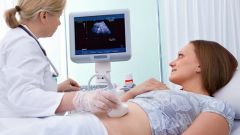Instruction
1
At the time of diagnosis using the ultrasound revealed a large number of disorders and diseases of the internal organs. The method is absolutely harmless to humans and has a wide availability due to the relatively low cost of the apparatus. Ultrasound findings known immediately, but the procedure itself does not bring the patient any discomfort and pain.
2
Currently, ultrasound is used for diagnosing diseases of organs of small pelvis, abdominal cavity, prostate, mammary glands, joints, tissues, heart, thyroid, eyes, lymph nodes, blood vessels and many other organs and tissues. With the help of ultrasound studies during pregnancy. There are modern 3D devices, allowing to build the most detailed picture and see the face of the unborn child. Technical innovation is a colored ultrasound, its use is most relevant in the diagnosis of vascular diseases.
3
During the examination the patient lies on the couch, the doctor puts on the skin of the examined area with a special gel and using a sensor, conducting a survey, comparing the obtained results with the accepted norm. The use of ultrasound in head injury allows you to find the location of hemorrhages, find the midline of the brain. Breast ultrasound reveals pathological processes. Ultrasound of internal organs show changes and abnormalities in their structure, detects the presence of adhesive processes and fluid in the abdominal cavity. Detects cirrhosis of the liver, hepatitis, cholelithiasis, etc. Allows us to deliver more accurate diagnosis and to choose the right tactics of treatment.
4
Study of the heart helps to keep track of his work during surgery and reveals pathology in his work. Ultrasound of the kidneys, bladder, male and female sexual organs reveals benign and malignant tumors and some diseases. Ultrasound examination allows to assess the condition of the fetus, to identify congenital and hereditary diseases, the development of the fetus, in pregnancy, to assess the condition of the genital organs of the mother. The number of studies is limited. Usually performed in 11, 20 and 30 weeks.
5
Despite all the advantages of ultrasound, remember that the doctor conducting the study needs to give conclusion and treatment should get your doctor. When choosing treatment it should be based on the totality of data obtained from ultrasound, analyses and research. The accuracy and reliability of ultrasound depends on the available features and chronic diseases of the patient, the monitor size and performance of the device.

